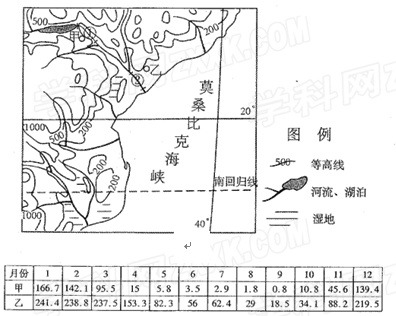(10分)下图示意世界某区域,下表为图中甲、乙两地的各月降雨量表(单位:毫米)阅读图表完成下列问题。

(1)描述该区域的地形特征。(3分)
(2)比较①、②河段水文特征的差异。(2分)
(3)比较甲、乙地降雨量的差异,并分析原因。(5分)
(1)(3分)高原为主(1分);西北高东南低(1分);海岸线平直(1分)。
(2)(2分)①河段较②河段流量小(1分),水位(径流)季节变化较小(1分)。
(3)(5分)甲地降雨量比乙地小(1分)。原因:甲地距海较远,受暖流影响较小(1分), 处于东南信风的背风地带,降水量较小(1分);乙地距海较近,受暖流影响较大(1分), 处于东南信风的迎风地带,降水量较大(1分)
题目分析:
(1)读图,根据等高线数值分析,大部分是海拔在500-1000米以上,1000米等高线内部平坦,所以地形以高原为主,地势西北高东南低。图中海湾少,海岸线平直。
(2)读图分析,①河段源头是湖泊,没有其它支流注入,②河段有几条支流注入,包括①河段水量,所以①河段比②河段流量小。①河段源头是湖泊,水源补给稳定,所以水位季节变化较小。
(3)读图,可以判断是非洲南部,沿岸有暖流经过,甲地距海较远,受暖流影响较小,从地形、气压带风带角度分析,甲地处于东南信风的背风地带,所以降水量较小。乙地距海较近,受暖流影响较大,处于东南信风的迎风地带,所以降水量较大。因此甲地降雨量比乙地小。
